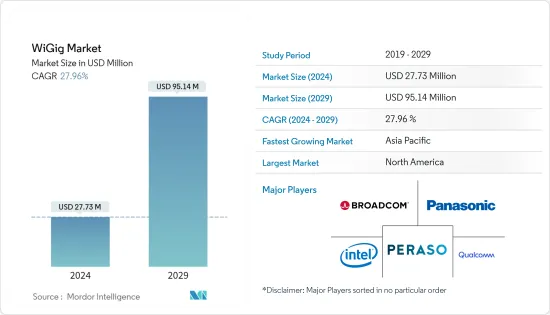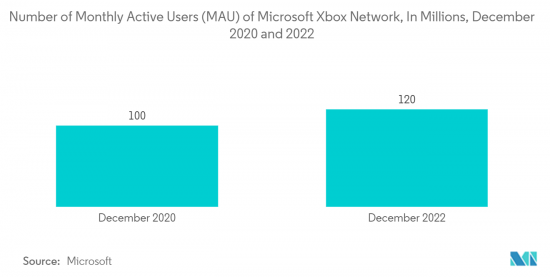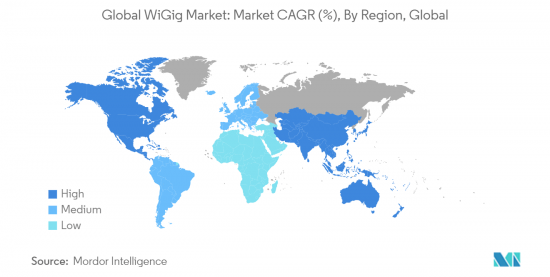 |
市場調查報告書
商品編碼
1429225
WiGig(無線千兆位元):市場佔有率分析、產業趨勢/統計、成長預測(2024-2029)WiGig - Market Share Analysis, Industry Trends & Statistics, Growth Forecasts (2024 - 2029) |
||||||
※ 本網頁內容可能與最新版本有所差異。詳細情況請與我們聯繫。
WiGig(無線千兆)市場規模預計到2024年為2773萬美元,預計到2029年將達到9514萬美元,在預測期內(2024-2029年)複合年成長率為27.96%。

推動WiGig市場成長的因素包括不斷成長的頻寬需求、智慧型手機飽和狀態以及各種設備的使用,所有這些都有助於行業的整體發展。此外,新興經濟體 IT 支出的增加和預算分配的變化正在推動對支援當前主導基礎設施的技術先進產品的需求。
主要亮點
- 公共 Wi-Fi 有助於實現各種智慧城市目標,包括彌合數位落差、實現基於物聯網 (IoT) 的城市服務,以及為居民、學生、訪客和遊客提供便利設施。這加上各國政府機構對智慧城市改善的投資不斷增加,是推動市場成長的主要原因之一。除此之外,許多公司都使用 WiGig 設備來允許員工透過各種設備完成工作,而無需電纜連接的負擔。
- 為了在辦公室中實現高效聯網,還可以移動大型文件、無縫運行佔用頻寬的程序,以及以超低延遲將影像和音頻投影到會議室和禮堂的寬螢幕上。 WiGig 產品也用於便利的公共資訊亭服務以及行動電話、筆記型電腦、投影機和平板電腦等裝置之間的無線對接。它也經常用於下載高清 (HD) 電影、同時串流多個超高清影片、身臨其境型遊戲、擴增實境(AR)、虛擬實境 (VR) 體驗等。這加上消費者在數位媒體上的支出增加,正在推動產業擴張。
- 各最終用途產業的組織越來越偏好BYOD 政策,這創造了對 WiGig 的強勁需求,這將在未來幾年推動市場發展。向 BYOD 的轉變使企業能夠增加IT基礎設施預算以提高網路速度。職場中行動電話、筆記型電腦、桌上型電腦和其他電子設備的使用增加,增加了對高頻寬和網際網路速度來支援許多應用程式和服務的依賴。此外,對高速網路連線的需求不斷成長,以加快應用程式和業務相關活動的速度,也推動了市場的擴張。
- 技術限制是全球WiGig市場參與企業面臨的主要問題。目前技術的運作頻率高於 60Hz,但現代 Wi-Fi 產品僅使用 2.4 至 5GHz 之間的頻率。因此,目前的基礎設施需要升級,這需要客戶大量的資金投入。
- 疫情期間,在家工作已成為一大趨勢。向大規模遠端工作轉變的速度導致了行動電話、平板電腦和桌上型電腦等個人設備的使用。我們也看到員工使用個人 Wi-Fi 和網路連線來存取公司網路。此外,在後 COVID-19 的情況下,Wi-Fi 的使用增加,以維持業務和關鍵功能的運作。
WiGig市場趨勢
遊戲和多媒體推動市場
- 更複雜的線上多人遊戲教導玩家策略性和分析性地評估風險和回報。這些遊戲需要年輕玩家對遊戲的變化做出快速反應。孩子們從這個遊戲中受益匪淺,因為他們學到的技能可以應用於現實世界中需要解決問題、分析技能和策略思考的工作。遊戲是孩子們了解不同思維方式和文化的好方法,因為他們可以沉浸在虛擬世界中,有時還可以與來自世界各地的人們交流。這些趨勢預計將增加遊戲領域對 WiGig 市場的需求。
- 近年來,隨著端到端的本地遊戲開發,網路生態系統開始改變方向。例如,Zynga 在從社交轉向行動的過程中掙扎了幾年,但到 2022 年 2 月,其第四季銷售額年增 52%,達到 7.27 億美元。該公司於 2019 年 6 月推出了免費遊戲 Farmville-3,但 Zynga 創建的基於 Flash 的遊戲主要設計用於在 Facebook 內玩。
- 據行動視訊產業委員會稱,由於近幾個月雲端遊戲服務的快速發展,行動電信業者預計到2022年雲端遊戲將佔5G資料流量的25-50%。 Over-the-Top (OTT) 公司也有雄心勃勃的計劃,要成為“遊戲界的 Netflix”,託管數千個易於訪問的遊戲庫,並最終提供 5G 網路頻寬。未來如此高的頻寬將需要使用WiGig。
- 此外,微軟表示,截至 2022 年 12 月,微軟線上遊戲服務的月有效用戶數量已從 2016 年初的略低於 4,000 萬增加到約 1.2 億。該服務之前稱為 Xbox Live,直到 2023 年 3 月才更名為 Xbox Network,以區別於 Xbox Live Gold 訂閱服務。對此類線上主機的需求不斷成長預計將推動研究市場的發展。
- 此外,Razer Edge 將於 2023 年 1 月透過 Verizon 在美國上市。 Razer Edge 搭載 Snapdragon G3x Gen 1 處理器,據信該處理器是基於 Snapdragon 888。 6.8 吋 AMOLED 顯示螢幕,解析度為 2,400 x 1,080px (20:9),刷新率為 144Hz,使其比 Steam Deck 和 Nintendo Switch 等產品更具優勢。相比之下,Switch 的 OLED 為 7 英寸,Steam Deck 的為 7 英寸 LCD,但兩者的解析度均為 720p,運作頻率均為 60Hz。

亞太地區預計將創下最高市場成長紀錄
- IEEE 802.11aj是IEEE 802.11TM的修訂標準,規定了60GHz和45GHz頻段的物理(PHY)層和介質訪問控制(MAC)層,以滿足中國對高速無線局域網容量日益成長的需求。 。此次標準變更在 60GHz 頻段定義了 4 個 1.08GHz 通道,以支援具有高資料傳輸和寬覆蓋區域的低功耗設備,並在 45GHz 頻段定義了新的 5GHz頻寬,可支援高達 15Gb/s 的資料傳輸速度。實現了。這增強了 IEEE 802.11(Wi-Fi 網路設備的基礎)的功能。
- 2022年9月,藤倉開發了無需許可證即可在日本獨立檢驗技術標準合規性認證的60GHz頻段毫米波無線通訊模組,並開始分發樣品。新開發的60GHz頻段毫米波無線通訊模組對結構進行了改進和最佳化,以獲得技術標準合規認證。此模組被賦予認證機構的技術標準合格認證標誌。這使得開發配備該模組的通訊設備和工業設備變得更加容易。
- 2022年2月,日本電報電話公司(NTT)實現了全球首個60GHz無線區域網路(WiGig),利用終端主導的動態站點分集控制技術,實現了高速移動條件下不間斷的大容量無線區域網路傳輸。實現了。 NTT 的「終端主導的動態站點分集控制技術」即使在 WiGig 等非行動無線通訊系統中也能實現與高速行動終端的連續高容量無線連接。可用於無人機、汽車的即時影像傳輸、大量資料傳輸等。
- 同樣,印度電訊機構 ITU-APT 基金會 (IAFI) 最近推動取消 V 頻段 (60GHz)頻寬的許可,允許在不競標的情況下授予許可,從而降低成本。透過保持較低的成本,我們正在為政府旨在彌合數位落差的「全民WiFi」計劃。此外,60GHz 頻段 (57-64GHz) 的新技術可提供類似光纖的可靠性和數千兆Gigabit速度,同時實現比現有光纖低一個數量級的成本。與光纖和傳統毫米波骨幹網路相比,60 GHz 頻段的一些新技術可以節省個位數到兩位數的成本。
- 營運商和設備製造商越來越了解整相陣列天線和電子束控制技術的優勢,並引發了監管委員會的討論。萊迪思最近參與了華為進行的一項技術分析,該分析構成了多家公司向 CEPT 固定服務工作組 (ECC SE 19)提案的文件的基礎,倡導監管改革作為這項工作的一部分。萊迪思提供了目前無線基礎設施解決方案的系統參數,使華為能夠在城市部署模擬中模擬傳播特性和干擾機率。
- 60GHz 頻段是在裝置之間無線傳輸高品質、低延遲 4K 視訊的唯一途徑。其他無線解決方案需要對 4K 視訊進行大量壓縮,從而導致低品質、高延遲的視訊體驗。無線 60 GHz 可實現裝置之間的順暢無線通訊,無需干擾電線。 60GHz 頻段的頻寬為 7GHz,可滿足越來越多的連網裝置所需的容量。個人使用的資料量和連結設備的數量持續增加。 60GHz 頻段可以處理更多資料和連接,同時提供更好的使用者體驗。

WiGig 產業概述
WiGig 市場分散,全球參與者競相創新以消除市場挑戰,這可能會阻礙當前的成長。主要參與者包括英特爾公司、松下公司和高通科技公司。
- 2023 年 10 月 Tarana Wireless, Inc. 宣布其先進的固定無線存取 (ngFWA) 平台 Gigabit 1 將能夠在即將在美國推出的新的免許可 6GHz 頻段中運作。在美國,許多公共和私人組織目前正在努力解決寬頻問題。
- 2023 年 11 月 網路解決方案供應商 Cambium Networks 宣布 Nextlink Internet 已下了一份重要訂單,以利用其先進的 ePMP 6GHz 固定無線寬頻解決方案增強其覆蓋範圍。 Nextlink 計劃主要使用 ePMP 在農村、低密度地區進行遠端連線。 Cambium Networks 對解決方案的策略性投資將顯著增強Gigabit固定無線的接入,使美國中心地帶的許多農村和郊區居民受益。
其他福利:
- Excel 格式的市場預測 (ME) 表
- 3 個月分析師支持
目錄
第1章簡介
- 研究假設和市場定義
- 調查範圍
第2章調查方法
第3章執行摘要
第4章市場洞察
- 市場概況
- 產業吸引力-波特五力分析
- 供應商的議價能力
- 買方議價能力
- 新進入者的威脅
- 替代品的威脅
- 競爭公司之間的敵對關係
- 產業價值鏈分析
- 評估 COVID-19 對產業的影響
第5章市場動態
- 市場促進因素
- 通訊業的技術不斷進步
- 高畫質影片的採用率增加
- 市場限制因素
- WiGig 產品的工作範圍短
第 6 章 技術概覽
第7章市場區隔
- 產品
- 顯示裝置
- 網路基礎設施設備
- 目的
- 遊戲和多媒體
- 聯網
- 其他用途
- 地區
- 北美洲
- 歐洲
- 亞太地區
- 世界其他地區
第8章 競爭形勢
- 公司簡介
- Panasonic Corporation
- Qualcomm Technologies Inc.
- Intel Corporation
- Broadcom Inc.
- Peraso Technologies Inc.
- Blu Wireless Technology Limited
- Tensorcom Inc.
- Fujikura Ltd
- Sivers Ima Holding AB
- Cisco Systems Inc.
- Dell Technologies Inc.
- Lenovo Group Limited
- HP Development Company LP
第9章投資分析
第10章市場的未來
The WiGig Market size is estimated at USD 27.73 million in 2024, and is expected to reach USD 95.14 million by 2029, growing at a CAGR of 27.96% during the forecast period (2024-2029).

The factors driving the growth of the Wireless Gigabit Market include an increase in bandwidth demand, a saturation of smartphones, and the use of various devices, all of which contribute to the overall industry development. Furthermore, rising IT spending and shifting budget distributions in emerging economies drive demand for technically advanced items to support the current initiative infrastructure.
Key Highlights
- Public Wi-Fi contributes to various smart city goals, including bridging the digital divide, allowing Internet of Things (IoT)-based city services, and offering amenities for residents, students, visitors, and tourists. This, together with increased investments in smart city improvements by government agencies from various nations, is one of the primary reasons driving the market growth. Apart from that, WiGig devices are used in many enterprises to allow employees to finish work from various devices without the burden of a cable connection.
- They are also used for effective in-office networking, moving huge files, seamlessly running bandwidth-intensive programs, and projecting visuals and audio on a wide screen in a conference room or auditorium with very low latency. WiGig products are also used in handy public kiosk services and wireless docking between devices such as cellphones, laptops, projectors, and tablets. They are also frequently used for high-definition (HD) movie downloads, simultaneous streaming of multiple ultra-HD videos, and immersive gaming, augmented reality (AR), and virtual reality (VR) experiences. This, together with rising consumer expenditure on digital media, is fueling industry expansion.
- The growing preference for BYOD policies among organizations operating in various end-use industries is creating a considerable demand for WiGig, which will drive the market in the future. This shift toward BYOD allows enterprises to increase their IT infrastructure budgets to improve network speed. The rising usage of mobile phones, laptops, desktop computers, and other electronic devices at work is creating a major reliance on high bandwidth and internet speed to support the many apps and services. Furthermore, the growing necessity for a high-speed internet connection to speed up applications and work-related activities is fueling market expansion.
- Technological constraints are the main issue confronting industry participants in the worldwide WiGig market. The current technology operates at frequencies over 60Hz; however, the frequencies employed in contemporary Wi-Fi products are only between 2.4 and 5 GHz. As a result, there is a need to upgrade the current infrastructure, which will need a significant capital commitment from customers.
- Working from home has become a megatrend during the pandemic days. The speed of the shift to large-scale remote work has resulted in the use of personal devices, including mobile phones, laptops, tablets, desktops, etc. Employees are also observed using personal Wi-Fi and internet connections to access the corporate network. Moreover, in the post COVID-19 scenario, the market boosted Wi-Fi use to keep businesses and critical functions operational.
WiGig Market Trends
Gaming and Multimedia Expected to Drive the Market
- The more complex online multiplayer games educate players on strategically and analytically assessing risk and reward. These games require young players to react fast to game changes. Children gain from this game because the abilities learned can be applied to real-world careers that require problem-solving, analytical skills, and strategic thinking. Games may be a terrific method for children to learn about diverse ideas and cultures since they allow them to immerse themselves in virtual worlds and, at times, communicate with people from all over the world. Such trends would raise the demand for the wireless gigabit market in gaming.
- In recent years, the internet ecosystem has initiated course correction by end-to-end local game development. For instance, Zynga's shift from social to mobile meant several tough years, but in February 2022, it reported Q4 revenue of USD 727 million, up by 52% year-over-year. It launched its free game Farmville-3 in June 2019, but the Flash-based game created by Zynga was primarily designed to be played within Facebook.
- According to the Mobile Video Industry Council, mobile operators expected cloud gaming to represent 25-50% of 5G data traffic by 2022, owing to the quick progression of cloud gaming services in recent months. Over-the-top (OTT) players also have ambitious plans to become the 'Netflix for gaming,' hosting libraries of thousands of immediately accessible games that will ultimately consume three to four times the amount of bandwidth on 5G networks compared to standard definition video traffic. Such high bandwidth will require the use of WiGig in coming future.
- Additionally, According to Microsoft, Microsoft's online gaming service had around 120 million monthly active users as of December 2022, up from just under 40 million at the start of 2016. The service was previously known as Xbox Live until being rebranded as Xbox Network in March 2023 to distinguish it from the Xbox Live Gold subscription service offering. Such a rise in demand for online consoles is expected to drive the studied market.
- Furthermore, In January 2023, the Razer Edge will be available in the United States through Verizon. The Razer Edge is powered by a Snapdragon G3x Gen 1 processor, which appears to be based on the Snapdragon 888. The 6.8" AMOLED display with 2,400 x 1,080px resolution (20:9) and 144Hz refresh rate provides it an advantage (heh) over the likes of the Steam Deck and the Nintendo Switch. In comparison, the Switch OLED has a 7-inch display, and the Steam Deck has a 7-inch LCD, but both feature just 720p resolution and run at 60Hz.

Asia-Pacific is Expected to Register the Highest Market Growth
- IEEE 802.11aj, an amendment to IEEE 802.11TM that specifies the Physical (PHY) layer and the Medium Access Control (MAC) layer in the 60 GHz and 45 GHz bands to accommodate expanding high-speed wireless LAN capacity demands in China, was authorized by IEEE and the IEEE Standards Association (IEEE-SA). The standard modification defines four 1.08 GHz channels in the 60 GHz band to support low-power devices with high data rates and broader coverage areas, as well as 5 GHz of new bandwidth in the 45 GHz band with up to a 15 Gb/s data rate. This enhances the capabilities of IEEE 802.11, the foundation of Wi-Fi networking equipment.
- In September 2022, Fujikura Ltd. developed and began distributing samples of a 60 GHz millimeter-wave wireless communication module that may be independently verified for Technical Regulations Conformity Certification in Japan, which does not require a license. The newly developed 60 GHz band millimeter-wave wireless communication module's structure has been upgraded and optimized to qualify for Technical Regulations Conformity Certification. This module will be provided with a certifying body's Technical Rules Conformity Certification mark. Its pre-certification greatly simplifies the development of communication and industrial equipment with the module.
- In February 2022, Nippon Telegraph and Telephone Corporation, Japan implemented 60-GHz band wireless LAN (WiGig) for the first time globally, achieving uninterrupted large-capacity wireless transmission in high-speed mobility situations using terminal-driven dynamic site diversity control technology. NTT's terminal-driven dynamic site diversity control technology enables even non-mobile wireless communication systems like WiGig to achieve continuous high-capacity wireless connections to high-speed mobile terminals. It can be utilized for real-time video transmission from drones and autos and batch data transmission.
- Similarly, recently, the ITU-APT Foundation of India (IAFI), a telecom industry organization, has pushed to delicense spectrum in the V-band (60 GHz range), allowing it to be granted without auctions and so keeping costs low, thereby aiding in the government's 'WiFi-for-all' effort to bridge the digital divide. Additionally, new technologies in the 60 GHz band (57-64 GHz) can achieve cost points an order of magnitude lower than existing fiber while providing fiber-like reliability and multigigabit speeds. Certain new 60 GHz band technologies can offer cost savings of one or two orders of magnitude over fiber and conventional milli-metric band backbone networks.
- The rising understanding of the benefits of phased array antenna and electronic beam-steering technology among operators and equipment makers is now translating into a debate among regulatory committees. Lattice recently participated in a technical analysis conducted by Huawei that forms the basis of a multi-company proposal to the Fixed Service working group in CEPT (ECC SE 19) advocating regulatory reform as part of this effort. Lattice provided the system parameters for their current wireless infrastructure solution, allowing Huawei to simulate the propagation characteristics and interference probability in an urban deployment simulation.
- The only way to wirelessly stream high quality, low latency 4K video across devices is at 60 GHz. Other wireless solutions must drastically compress 4K video, resulting in a lower quality and higher latency video experience. There aren't any cords. 60 GHz enables for smooth wireless communications between devices, removing the need for obtrusive cords and wires. The 60 GHz spectrum has 7 GHz of bandwidth, which provides the required capacity for the expanding number of Internet-connected devices. The amount of data that individuals utilize and the number of linked gadgets will only grow. The 60 GHz band can handle more data and connections while providing a better user experience.

WiGig Industry Overview
The WiGig market is fragmented in nature, as the global players are competing to innovate the technology to remove the market challenges, which can hamper the current growth. The key players are Intel Corporation, Panasonic Corporation, and Qualcomm Technologies Inc., among others.
- October 2023: Tarana Wireless, Inc. announced that its advanced fixed wireless access (ngFWA) platform, Gigabit 1, has the capability to operate in the expansive new unlicensed 6 GHz spectrum that will soon be accessible in the United States. Numerous public and private organizations in the country are currently dedicating their efforts to addressing the ongoing broadband challenges.
- November 2023: Cambium Networks, a networking solutions provider, announced that Nextlink Internet has made a substantial order to enhance its coverage area with the advanced ePMP 6 GHz fixed wireless broadband solution. Nextlink intends to utilize ePMP primarily to connect remote areas in low-density rural regions. This strategic investment in Cambium Networks solutions will greatly enhance gigabit fixed wireless accessibility, benefiting numerous rural and suburban residents throughout the American heartland.
Additional Benefits:
- The market estimate (ME) sheet in Excel format
- 3 months of analyst support
TABLE OF CONTENTS
1 INTRODUCTION
- 1.1 Study Assumptions and Market Definition
- 1.2 Scope of the Study
2 RESEARCH METHODOLOGY
3 EXECUTIVE SUMMARY
4 MARKET INSIGHTS
- 4.1 Market Overview
- 4.2 Industry Attractiveness - Porter's Five Forces Analysis
- 4.2.1 Bargaining Power of Suppliers
- 4.2.2 Bargaining Power of Buyers
- 4.2.3 Threat of New Entrants
- 4.2.4 Threat of Substitutes
- 4.2.5 Intensity of Competitive Rivalry
- 4.3 Industry Value Chain Analysis
- 4.4 Assessment of Impact of Covid-19 on the Industry
5 MARKET DYNAMICS
- 5.1 Market Drivers
- 5.1.1 Growing Technological Advancements in the Communications Industry
- 5.1.2 Rising Adoption of High-resolution Videos
- 5.2 Market Restraints
- 5.2.1 Shorter Operating Range of WiGig Products
6 TECHNOLOGY SNAPSHOT
7 MARKET SEGMENTATION
- 7.1 Product
- 7.1.1 Display Devices
- 7.1.2 Network Infrastructure Devices
- 7.2 Application
- 7.2.1 Gaming and Multimedia
- 7.2.2 Networking
- 7.2.3 Other Applications
- 7.3 Geography
- 7.3.1 North America
- 7.3.2 Europe
- 7.3.3 Asia-Pacific
- 7.3.4 Rest of the World
8 COMPETITIVE LANDSCAPE
- 8.1 Company Profiles
- 8.1.1 Panasonic Corporation
- 8.1.2 Qualcomm Technologies Inc.
- 8.1.3 Intel Corporation
- 8.1.4 Broadcom Inc.
- 8.1.5 Peraso Technologies Inc.
- 8.1.6 Blu Wireless Technology Limited
- 8.1.7 Tensorcom Inc.
- 8.1.8 Fujikura Ltd
- 8.1.9 Sivers Ima Holding AB
- 8.1.10 Cisco Systems Inc.
- 8.1.11 Dell Technologies Inc.
- 8.1.12 Lenovo Group Limited
- 8.1.13 HP Development Company LP













